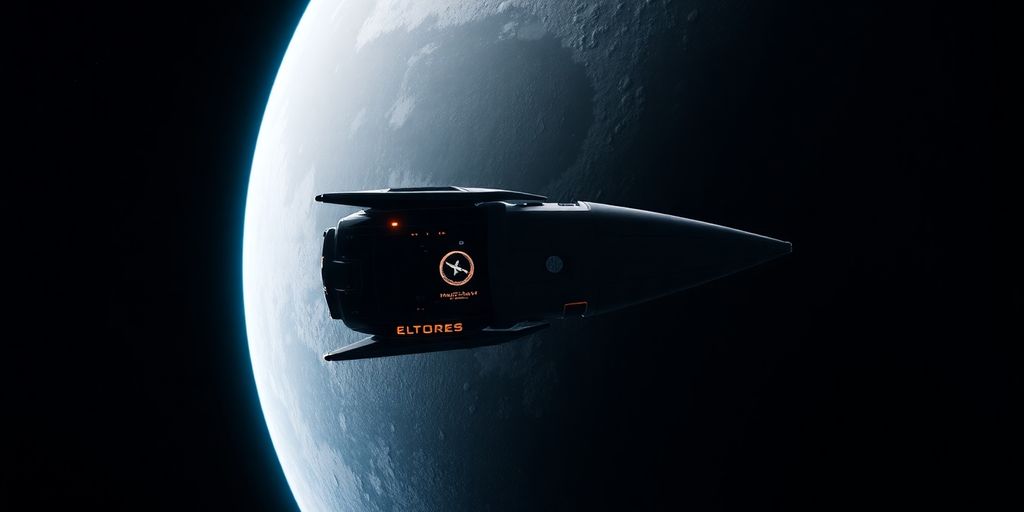Lunar tourism is no longer a distant dream; it’s becoming a reality for those who can afford it. With companies like SpaceX paving the way, the idea of taking a trip to the moon is enticing more than just scientists and astronauts. Now, the elite are booking exclusive moon tours that promise a unique adventure far beyond Earth. This article explores what lunar tourism entails, how to book such a journey, and what travelers can expect from their cosmic experience.
Key Takeaways
- Lunar tourism is gaining traction, with major players like SpaceX leading the charge.
- Booking a moon trip involves a detailed process, including health screenings and hefty deposits.
- Travelers should prepare for physical training and essential packing for their lunar adventure.
- Experiencing the moon includes exploring its surface and visiting historic Apollo sites.
- While costs are high now, they may decrease as technology advances and competition grows.
The Rise of Exclusive Moon Tours

Understanding Lunar Tourism
Okay, so lunar tourism is becoming a thing. I mean, who wouldn’t want to go to the moon? It’s not just about seeing cool rocks; it’s about bragging rights, right? But seriously, lunar tourism is more than just a fancy vacation. It’s a whole new industry that’s starting to take shape. It’s about pushing boundaries and doing something only a handful of people can even dream of.
It’s wild to think that soon, regular people (well, super-rich regular people) will be able to experience something that was once only for astronauts. It’s a shift in perspective, a new frontier, and a chance to see our planet from a completely different angle.
Key Players in the Market
Who’s making this happen? Well, you’ve got your usual suspects – the big names in space exploration. Think SpaceX, Blue Origin, and maybe even Virgin Galactic getting in on the action. These companies are pouring tons of money into developing the tech to make space tourism a reality. They’re not just building rockets; they’re creating entire experiences. It’s like building a luxury hotel, but instead of a beach view, you get the entire Earth.
Here’s a quick rundown:
- SpaceX: Known for reusable rockets and ambitious goals.
- Blue Origin: Focused on making space accessible through reusable launch vehicles.
- Virgin Galactic: Aiming to provide suborbital spaceflights for tourists.
The Appeal of Moon Travel
Why the moon? What’s the big deal? Well, for starters, it’s the ultimate adventure. It’s something that less than 600 people have ever done. That’s exclusivity at its finest. Plus, think about the views! Seeing Earth from the moon? That’s an Instagram post that’ll break the internet. But beyond the bragging rights, there’s a deeper appeal. It’s about pushing the limits of human exploration and experiencing something truly unique. It’s about the overview effect trips to the moon and seeing our planet as a whole, fragile ecosystem. It’s a perspective shift that could change your life.
Booking Your Lunar Adventure
Pre-Screening Requirements
So, you’re thinking about booking a trip to the moon? Awesome! First things first, you can’t just hop on a rocket. There’s some serious pre-screening involved. Think of it like applying for a super exclusive club, but instead of a background check, it’s a full-on medical and psychological evaluation. They need to make sure you can handle the physical stress of space travel. This isn’t your average vacation, after all. Expect things like:
- Intense physical exams to check your heart, lungs, and overall fitness.
- Psychological evaluations to see how you handle stress and isolation.
- Age limits – many companies are looking at people between 18 and 70.
Basically, they want to make sure you won’t freak out in zero gravity or have a heart attack during launch. It’s all about safety first, and making sure you’re mentally prepared for the experience. It’s a big deal to go to space, and they want to make sure you’re ready for it.
The Booking Process
Okay, you’ve passed the pre-screening. Now comes the actual booking. It’s not like buying a plane ticket, that’s for sure. The booking process is more like buying a house, but in space. You’ll probably start with a consultation to discuss your goals and preferences. Then, you’ll sign a contract and put down a significant deposit. Some companies even offer pre-launch packages that include special events and training leading up to the big day. Think of it as a VIP experience, but with spacesuits. To get started, check out bespoke space travel itineraries.
Payment and Deposits
Let’s talk money. This is where things get really interesting. We’re not talking about a few thousand dollars here. We’re talking millions. The cost of a lunar ticket is expected to be astronomical, at least initially. Think tens of millions of dollars. The deposit alone could be more than most people make in a lifetime. Here’s a rough breakdown:
- Initial Deposit: Could be anywhere from $500,000 to $2 million (or more!).
- Full Ticket Price: Expect to pay upwards of $50 million for a round trip.
- Payment Plans: Some companies might offer financing options, but be prepared for hefty interest rates.
It’s a huge investment, no doubt. But for the ultra-rich, it’s the ultimate status symbol. And who knows, maybe someday the price will come down, and lunar travel will be more accessible. But for now, it’s a luxury only a select few can afford. As technology advances, the cost of lunar travel will decrease.
Preparing for Your Moon Trip

So, you’ve booked your lunar getaway? Awesome! But before you start dreaming of moon rocks, there’s some prep work involved. It’s not exactly like packing for a beach vacation. Let’s get into what you need to do before you blast off.
Health and Fitness Training
Okay, this isn’t your average gym routine. We’re talking serious training to handle the unique stresses of space travel. Think about it: you’ll be dealing with G-forces during launch and re-entry that can make you feel several times heavier than normal. You’ll also need to get used to the whole zero-gravity thing.
Here’s a quick rundown of what to expect:
- G-Force Training: This involves using centrifuges to simulate the intense pressure you’ll feel during liftoff and landing. It’s not for the faint of heart, but it’s crucial for your body to adapt.
- Zero-Gravity Simulation: Expect sessions in specialized aircraft or underwater environments to get a feel for weightlessness. It’s fun, but also important for learning how to move and function without gravity.
- Medical Evaluations: You’ll undergo thorough check-ups to make sure you’re fit for space travel. They’ll assess your cardiovascular health, vision, and overall physical condition.
Don’t be surprised if you spend weeks, maybe even months, in training. It’s all about making sure you’re ready for the physical demands of space. They will also check your mental health to make sure you are ready for the isolation.
Packing Essentials for Space
Forget your swimsuits and sandals; you’re going to the moon! Packing for a lunar trip is all about practicality and survival. Most of the essentials, like food, water, and medical supplies, will be pre-packed. Spacecrafts have advanced life-support systems that handle oxygen and waste, so you don’t have to worry about the basics. But there are still some things you’ll want to bring:
- Space Suits: The most important item. These high-tech suits protect you from the vacuum of space, extreme temperatures, and provide oxygen. They’re designed for comfort and mobility, but they’re still bulky.
- Personal Items: You’ll want some familiar comforts from home. Photos, books, or small mementos can help with the psychological aspect of being away from Earth.
- Entertainment: Long journey? Pack things to keep you occupied. Books, tablets, or anything that doesn’t require gravity to function.
Safety Protocols
Safety is, obviously, a top priority. Before you even think about stepping onto the lunar surface, you’ll be drilled on safety procedures. You’ll learn what to do in case of emergencies, how to operate equipment, and how to handle the unique challenges of the lunar environment.
Here’s what you need to know:
- Emergency Procedures: You’ll be educated on what to expect during launch, the effects of zero gravity, and what to do in case of emergencies.
- Equipment Training: You’ll learn how to use all the equipment on board the spacecraft and on the moon, including communication devices, life support systems, and exploration tools.
- Contingency Plans: There are backup plans for everything. From equipment malfunctions to unexpected events, you’ll be prepared for any scenario.
With the right training, preparation, and mindset, traveling to the moon can be an amazing experience. Just remember to listen to your instructors, follow the safety protocols, and enjoy the ride! It’s a private spaceflights of a lifetime, after all.
Experiencing the Lunar Landscape

Exploring the Moon’s Surface
Okay, so you’ve made it to the moon! What’s next? Well, first, you get to actually walk on the moon. The feeling of low gravity is supposed to be pretty wild. Imagine hopping around like you’re on a trampoline, but the trampoline is the freaking moon! It’s not just about bouncing, though. You’ll get to see craters up close, maybe even some lunar plains. It’s a whole new world, literally.
Visiting Historic Apollo Sites
One of the coolest things about going to the moon is the chance to visit the spots where history happened. I’m talking about the Apollo landing sites. Can you imagine standing where Neil Armstrong took his first steps? It’s like visiting a museum, but the museum is an actual, real place on the moon. It’s a chance to connect with the past and see where humans first explored another world. These sites are a testament to human achievement, and seeing them in person would be something else. It’s a chance to see the lunar surface up close.
Unique Lunar Activities
Beyond just walking around and seeing the sights, there might be other stuff to do on the moon. Depending on who you’re going with, you might get to help with some lunar research. Or, if you’re staying longer, maybe hang out in some specially designed habitats. The views of Earth from the moon are supposed to be unreal. It’s a tiny blue marble in the blackness of space. It’s the kind of thing that makes you think about your place in the universe.
It’s not just a vacation; it’s a perspective shift. Seeing Earth from the moon can change how you see everything. It’s a reminder of how fragile and precious our planet is, and how important it is to take care of it. It’s an experience that can stay with you long after you’ve returned home.
The Cost of Lunar Travel
Understanding Price Ranges
Okay, let’s talk money. How much does it really cost to go to the moon? Well, right now, we’re talking serious cash. Early estimates put the price of a lunar ticket in the tens of millions of dollars. Think of it like buying a private island, but instead of sand, you get craters. As technology gets better and more companies jump into the space tourism game, the hope is that prices will come down. But for now, it’s an exclusive club for the super-rich.
Factors Influencing Costs
So, what makes a moon trip so expensive? A bunch of things, actually:
- Rocket development: Building rockets that can actually get to the moon isn’t cheap. All that research, testing, and engineering adds up.
- Fuel: Space travel requires a lot of fuel. Like, an unbelievable amount. And fuel costs money.
- Safety measures: You can’t cut corners when it comes to safety. Redundancy, backup systems, and rigorous testing are all essential, and they all cost money.
- Training: You can’t just hop on a rocket and go. Astronaut training is intense, and space tourists will need some level of preparation too.
The distance to the moon is a major factor. It’s not just a quick hop; it’s a journey of hundreds of thousands of miles. This requires powerful rockets, lots of fuel, and sophisticated navigation systems, all of which contribute to the high cost.
Future Price Predictions
What about the future? Will moon trips ever be affordable for regular folks? Maybe, someday. As technology improves and competition increases, prices should come down. We might see a tiered system, with super-expensive, ultra-luxurious trips for the elite and more "budget-friendly" (relatively speaking) options for those who are merely very wealthy. Some experts predict that the market for lunar tourism could be worth billions by the mid-2030s, which suggests a lot of investment and innovation in the field. It’s a long shot, but who knows? Maybe one day, a trip to the moon will be like a really, really expensive vacation.
The Future of Lunar Tourism
Technological Advancements
Okay, so, the future? It’s all about tech, right? For lunar tourism, that’s especially true. We’re talking about needing better rockets, more efficient life support systems, and ways to deal with radiation. The more advanced the tech, the cheaper and safer these trips become. Think about it: self-landing rockets, closed-loop recycling systems… stuff that sounds like sci-fi but is actually being worked on right now. It’s not just about getting there; it’s about making it sustainable.
Potential Lunar Habitats
Imagine hotels on the moon. Seriously! That’s where we’re headed. These lunar habitats won’t just be places to sleep; they’ll be research stations, manufacturing hubs, and, yeah, tourist destinations. They’ll need to be shielded from radiation and micrometeorites, have their own power sources, and be able to grow food. It’s a huge undertaking, but it’s also what will make longer stays possible.
Long-Term Vision for Moon Colonization
Okay, this is where it gets really interesting. Lunar tourism isn’t just about sightseeing; it’s a stepping stone to something bigger: colonization. The moon could become a base for exploring the rest of the solar system. We could mine resources, build spacecraft, and even launch missions to Mars from there. It’s a long shot, sure, but the potential is there. And who knows, maybe one day, you’ll be able to book a private spaceflight to the moon as easily as you book a flight to Europe.
The idea of humans living and working on the moon is no longer just a dream. It’s a goal that’s driving innovation and investment in space technology. And as lunar tourism grows, it will play a key role in making that vision a reality.
Psychological Aspects of Moon Travel
The Overview Effect
Okay, so imagine seeing Earth from the moon. Wild, right? It’s not just a cool view; it’s a total mind trip. Astronauts talk about something called the Overview Effect. It’s when seeing our planet from space makes you realize how fragile and connected everything is. It’s like suddenly understanding the big picture, and it can change how you see, well, everything. I bet lunar tourists will feel something similar, maybe even more intense since it’s such a rare experience for non-astronauts.
Existential Reflections
Going to the moon isn’t just a vacation; it’s a journey into the self. Being away from Earth, surrounded by the vastness of space, can trigger some serious existential thoughts. You might start questioning your place in the universe, what really matters, and what it all means. It’s like a forced introspection session, but with a killer view. It’s a chance to reflect on life, purpose, and the human condition, all while floating in low gravity. Whoa.
Social Status and Prestige
Let’s be real, going to the moon is a major flex. It’s not just about the experience; it’s about the bragging rights. Being one of the few people who’ve walked on the moon instantly elevates your social status. It’s a symbol of wealth, success, and adventure. It’s like saying, "Yeah, I went to the moon. What did you do this weekend?" It’s an exclusive club, and membership comes with serious prestige. It’s about exclusive offerings and showing the world you’re at the top.
It’s not just about the physical journey, but the psychological impact it has on the travelers. The moon represents a literal and metaphorical frontier, and for those who take the trip, it will likely be one of the most transformative experiences of their lives.
Here’s a quick breakdown of the social impact:
- Instant Credibility
- Networking Opportunities
- Bragging Rights
And here’s a table showing the perceived value:
| Aspect | Perceived Value |
|---|---|
| Exclusivity | Extremely High |
| Social Status | Very High |
| Bragging Rights | High |
Lunar Tourism and Environmental Considerations
Sustainability in Space Travel
Space travel, by its nature, is resource-intensive. We’re talking about rockets that burn massive amounts of fuel to escape Earth’s gravity. It’s important to think about how we can make lunar tourism more sustainable. This includes developing more efficient rockets, using alternative fuels, and minimizing waste. The goal is to reduce the environmental footprint of each trip.
- Developing reusable spacecraft.
- Using in-situ resource utilization (ISRU) to extract resources from the Moon.
- Implementing closed-loop life support systems.
Impact on the Lunar Environment
The Moon might seem like a vast, empty place, but it’s actually a delicate environment. Lunar dust, for example, can be very abrasive and can damage equipment and even pose a health risk to astronauts. We need to be careful about how we interact with the lunar surface to avoid causing irreversible damage. It’s not just about the dust, either. We need to think about light pollution from lunar bases and the potential for contamination from Earth-based microbes. The impact of lunar habitats needs to be carefully considered.
It’s easy to think of the Moon as a place where we can just do whatever we want, but that’s not the case. We have a responsibility to protect the lunar environment for future generations. This means being mindful of our impact and taking steps to minimize it.
Regulations and Guidelines
Right now, there aren’t a lot of specific regulations governing lunar tourism. The Outer Space Treaty of 1967 provides some broad guidelines, but it doesn’t address many of the specific challenges posed by commercial space activities. As lunar tourism develops, we’re going to need to establish clear regulations and guidelines to ensure that it’s done in a responsible and sustainable way. This includes things like setting limits on the number of lunar missions, establishing protected areas on the Moon, and developing protocols for dealing with emergencies. It’s also important to think about who gets to decide these rules. Should it be individual countries, international organizations, or private companies? The answers to these questions will shape the future of lunar exploration and tourism. Private space travel is transforming the industry.
- Establishing international agreements on lunar resource utilization.
- Developing environmental impact assessments for lunar missions.
- Creating a system for monitoring and enforcing regulations.
Here’s a simple table illustrating potential environmental impacts and mitigation strategies:
| Impact | Mitigation Strategy |
|---|---|
| Lunar Dust Disturbance | Developing dust mitigation technologies |
| Resource Depletion | Implementing ISRU and resource recycling |
| Contamination | Strict sterilization protocols for equipment and personnel |
The Role of Space Agencies in Lunar Tourism

NASA’s Involvement
NASA’s role in lunar tourism is complex. On one hand, they’re focused on scientific exploration and pushing the boundaries of space travel. On the other, they possess a wealth of knowledge and infrastructure that private companies need. NASA’s Artemis program, for example, aims to establish a sustainable presence on the Moon, which could pave the way for future tourism. They’re essentially laying the groundwork, conducting research, and developing technologies that commercial ventures can then utilize.
NASA’s historical data from the Apollo missions is invaluable. Private companies use this information to plan safer and more efficient lunar missions. It’s a collaborative relationship, even if it’s not always direct.
International Collaborations
Lunar tourism isn’t just a US thing; it’s a global endeavor. International collaborations are key. Space agencies from Europe (ESA), Japan (JAXA), and other countries are all contributing to lunar exploration and space development. These partnerships can involve sharing resources, expertise, and even mission responsibilities. For example, one agency might focus on developing lunar habitats, while another works on transportation systems. This shared approach helps to distribute the costs and risks associated with lunar missions, making lunar tourism more feasible in the long run.
Public vs. Private Sector Initiatives
The interplay between public and private sectors is interesting. Public agencies like NASA often focus on basic research and infrastructure development, while private companies concentrate on commercial applications, such as luxury space travel. There’s a constant push and pull between these two. Public funding supports the initial stages of lunar exploration, which then attracts private investment. This creates a cycle of innovation and growth. It’s not always smooth sailing, though. There are debates about who should control lunar resources and how to ensure that lunar tourism is sustainable and doesn’t damage the lunar environment.
Here’s a quick look at the potential revenue from space tourism:
| Year | Projected Revenue (USD) |
|---|---|
| 2030 | 5-10% of total space industry revenues |
| 2035 | $5 billion (lunar tourism alone) |
It’s a growing market, and both public and private entities want a piece of the pie.
Marketing Exclusive Moon Tours
Targeting the Elite
Reaching the right audience is key when you’re selling something as exclusive as a trip to the moon. It’s not about mass marketing; it’s about pinpointing those individuals who not only have the financial means but also the desire for such an extraordinary adventure. Think exclusive clubs, high-end travel agencies, and partnerships with luxury brands. The message needs to be tailored to their aspirations and values.
Creating Unique Experiences
It’s not just about getting to the moon; it’s about what happens before, during, and after the trip. We’re talking about crafting an experience that’s unparalleled. Consider:
- Personalized astronaut training programs.
- Exclusive access to pre-launch facilities.
- Custom-designed lunar modules with bespoke interiors.
- Post-trip celebrations and documentaries.
The goal is to create a narrative that resonates with the client’s sense of adventure and desire for exclusivity. It’s about making them feel like pioneers, not just tourists.
Leveraging Social Media
While traditional advertising might have its place, social media offers a unique opportunity to showcase the allure of lunar travel. But not just any social media. Think platforms frequented by high-net-worth individuals. Use high-quality visuals, behind-the-scenes content, and testimonials from early adopters. Consider partnering with influencers who embody the spirit of adventure and luxury. The space tourism industry is growing, and social media is a great way to reach potential customers.
Here’s a simple table showing potential social media strategies:
| Platform | Content Focus | Engagement Strategy |
|---|---|---|
| Stunning visuals, lifestyle content | Influencer collaborations, targeted ads | |
| Thought leadership, industry insights | Networking with potential investors and clients | |
| Private Forums | Exclusive content, personalized interactions | Direct engagement with high-net-worth individuals |
Don’t forget to highlight the luxury travel experiences that make these trips so special. And remember, it’s about building a community of visionaries and adventurers, not just selling tickets. Maybe even offer bespoke island-hopping experiences as a pre-moon trip warm up!
Challenges Facing Lunar Tourism
Safety Concerns
Space travel, even with all the advancements, still has risks. The environment is harsh, and things can go wrong quickly. We’re talking about extreme temperatures, radiation exposure, and the whole low-gravity thing. Companies are working hard on safety, with redundant systems and extensive training, but the inherent danger is still there. It’s not like hopping on a plane; it’s a whole different ballgame. The fatality risk for orbital missions is still significant, but hopefully, it will decrease as technology improves.
Regulatory Hurdles
Figuring out who gets to make the rules in space is a big headache. There’s no real international consensus on space tourism regulations. Who’s responsible if something goes wrong? What are the safety standards? It’s a legal gray area right now, and that uncertainty can slow things down. Plus, different countries have different ideas about what’s okay, so getting everyone on the same page is tough. This is why private space flights are so important.
Public Perception and Interest
Let’s be real, most people aren’t exactly thrilled about the idea of rich folks jetting off to the moon while there are problems here on Earth. There’s a perception that it’s a waste of resources, or that it’s just a vanity project for the elite. Changing that perception is going to be key to getting broader support for lunar tourism. It’s not just about the science or the adventure; it’s about showing how it can benefit everyone, not just the elite.
It’s important to show the public that lunar tourism isn’t just a playground for the wealthy. Highlighting the potential for scientific discovery, technological advancement, and even economic opportunities can help shift the narrative and build wider support.
Lunar tourism is an exciting idea, but it comes with some big challenges. From the high costs of space travel to safety concerns, there are many things to think about. If you’re curious about how these issues might affect your future trips to the moon, visit our website for more information and updates on lunar tourism!
The Future Awaits
In conclusion, lunar tourism is just starting to take shape, but it’s already stirring up excitement among those with the means to explore beyond Earth. Sure, the costs are sky-high right now, but as technology improves and more companies jump into the game, we might see prices drop. Imagine a future where a trip to the moon isn’t just for the ultra-rich but something more people can experience. For now, it’s a thrilling adventure that promises unforgettable views and a chance to be part of something historic. So, if you’ve got the cash and the courage, booking that moon trip could be the ultimate journey of a lifetime.
Frequently Asked Questions
What is lunar tourism?
Lunar tourism is when people travel to the moon for fun and adventure. It’s a new type of vacation that lets you explore the moon’s surface and experience space travel.
How do I book a trip to the moon?
To book a lunar trip, you need to find a space tourism company that offers moon trips. You’ll have to go through a health check and then pay a deposit to secure your spot.
How much does a trip to the moon cost?
A ticket to the moon can cost tens of millions of dollars right now. However, as technology improves, prices might drop in the future.
What do I need to do to prepare for a moon trip?
You need to be in good health and complete some training to get ready for the trip. This includes learning about living in space and how to stay safe.
What can I expect to see on the moon?
When you get to the moon, you can explore its surface, see craters, and even visit famous spots like where astronauts first landed.
Are there any risks involved with lunar travel?
Yes, traveling to the moon comes with risks, like safety concerns during the launch and landing. Companies are working on making space travel safer.
What is the future of lunar tourism?
The future looks bright for lunar tourism. With new technology, more people might be able to visit the moon, and there could even be bases for longer stays.
How does lunar tourism affect the environment?
Lunar tourism raises concerns about protecting the moon’s environment. Companies are looking for ways to make space travel more sustainable and limit any negative impacts.












